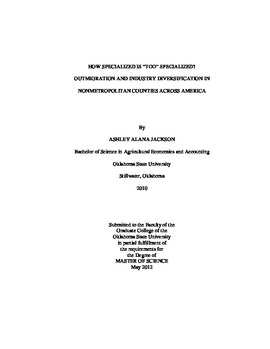| dc.contributor.advisor | Whitacre, Brian | |
| dc.contributor.author | Jackson, Ashley Alana | |
| dc.date.accessioned | 2014-04-15T19:52:43Z | |
| dc.date.available | 2014-04-15T19:52:43Z | |
| dc.date.issued | 2012-05-01 | |
| dc.identifier.uri | https://hdl.handle.net/11244/8691 | |
| dc.description.abstract | Outmigration and industrial composition have separately been the focal points of a significant amount of research related to nonmetropolitan counties; however, few (if any) studies have explicitly looked at the relationship between the two topics. The primary objective of this research is to identify what industry specialization level is "too" specialized with regards to outmigration - that is, to determine the level where specialization begins to have a damaging effect on population change. County-level data from a variety of sources is used to explore the impact of both earnings-based and employment-based definitions of specialization on net migration in nonmetropolitan counties from 2000 - 2009. Two distinct techniques (ordinary least squares and average treatment effects) are then used to assess both the impact and causality of being "too specialized." Economic development professionals utilize a large array of tools to encourage job growth and quality-of-life improvement in their regions. This research suggests that they should also consider current industrial employment thresholds when targeting long-term goals such as population growth. Dependency categories most commonly found to have a negative relationship with outmigration were farming and manufacturing. Service, recreation and retirement dependency were found to have a positive relationship with the net migration rate. It can also be concluded that each of these dependencies can cause either outmigration or in-migration, depending on the direction of the relationship previously stated. These conclusions are supported at both the national and regional levels. Key "too specialized" categories with a positive relationship with the net migration rate, and also said to cause in-migration included agriculture (20%), accommodation and food services (10% and 20%), and construction (10 and 20%). The "too specialized" categories with a negative relationship with the net migration rate, and also said to cause outmigration included agriculture (10%), accommodation and food services (30%), healthcare (10 and 20%), and manufacturing (10 and 20%). A thorough analysis of the results given for the nation in general and for individual regions should allow local leaders to efficiently create policies aimed at impacting their net migration rate by changing their industrial specialization and dependency levels to the optimal levels. | |
| dc.format | application/pdf | |
| dc.language | en_US | |
| dc.publisher | Oklahoma State University | |
| dc.rights | Copyright is held by the author who has granted the Oklahoma State University Library the non-exclusive right to share this material in its institutional repository. Contact Digital Library Services at lib-dls@okstate.edu or 405-744-9161 for the permission policy on the use, reproduction or distribution of this material. | |
| dc.title | How Specialized is "Too" Specialized? Outmigration and Industry Diversification in Nonmetropolitan Counties across America | |
| dc.type | text | |
| dc.contributor.committeeMember | Shideler, David | |
| dc.contributor.committeeMember | Doeksen, Gerald | |
| osu.filename | Jackson_okstate_0664M_12020.pdf | |
| osu.college | Agricultural Sciences and Natural Resources | |
| osu.accesstype | Open Access | |
| dc.description.department | Department of Agricultural Economics | |
| dc.type.genre | Thesis | |
| dc.subject.keywords | industrial diversification | |
| dc.subject.keywords | industrial specialization | |
| dc.subject.keywords | net migration | |
| dc.subject.keywords | nonmetropolitan | |
| dc.subject.keywords | outmigration | |
